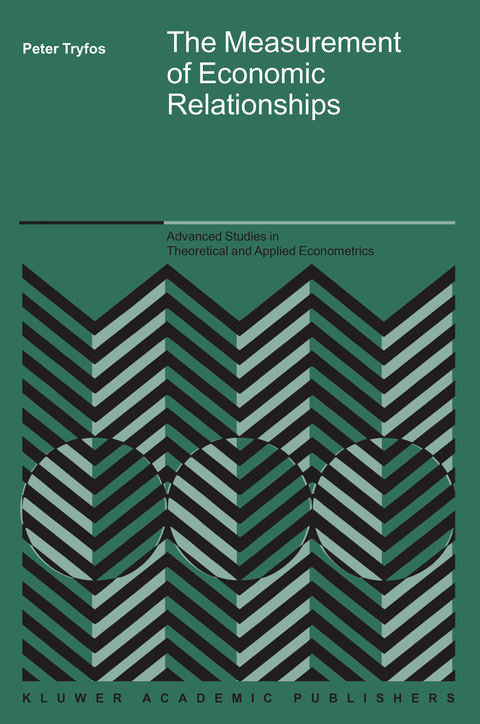
The Measurement of Economic Relationships
Springer-Verlag New York Inc.
978-1-4020-2838-0 (ISBN)
1 Introduction.- 1.1 The Status Quo.- 1.2 The CLM in Academic Studies.- 1.3 The CLM in Practice.- 1.4 Extensions of the CLM.- 1.5 The Road Ahead.- 2 The Fitting Method: An Introduction.- 2.1 Introduction.- 2.2 The Problem.- 2.3 The Available Information.- 2.4 One Solution.- 2.5 Least Squares and Spreadsheets.- 2.6 Constrained Least Squares.- 2.7 Tolerance Intervals.- 2.8 Joint Tests and Tolerance Regions.- 2.9 Interval Forecasts.- 2.10 Computer Output.- 2.11 In Summary.- 3 The Fitting Method: A Formal Treatment.- 3.1 Introduction.- 3.2 Relationships.- 3.3 Unrestricted Least Squares.- 3.4 Restricted Least Squares.- 3.5 Ordinary Tolerance Intervals and Regions.- 3.6 A Tolerance Region for All Parameters.- 3.7 Tolerance Interval Forecasts.- 3.8 Possible Extensions.- 4 The Clasical Linear Model.- 4.1 Introduction.- 4.2 The Assumptions of the CLM.- 4.3 Estimates and Their Properties.- 4.4 Statistical Inference.- 4.5 Specification Error.- 4.6 On Confidence Interval Estimates.- 4.7 The Many Problems of Significance.- 4.8 On Confidence Interval Forecasts.- 4.9 The Art and Practice of Statistical Inference.- 4.10 Bad Practice or Bad Theory?.- 5 The Central Assumptions.- 5.1 Introduction.- 5.2 True Parameters?.- 5.3 The Randomness of Error.- 5.4 Probability.- 5.5 The Central Limit Theorem and Normality.- 5.6 Are the Unknown Factors Random Variables?.- 5.7 Serial Correlation.- 5.8 The “As If” Argument.- 5.9 A Probable Deviation.- 5.10 On the Distribution of Residuals.- 5.11 In Summary.- 6 Random Processes.- 6.1 Introduction.- 6.2 The Coin Toss.- 6.3 Of Births and Deaths.- 6.4 Stock Market Prices.- 6.5 Some Perils of Time Series Analysis.- 6.6 In Conclusion.- 7 The “Probabilistic Revolution”.- 7.1 Introduction.- 7.2 Before Haavelmo.- 7.3 Haavelmo on Relationships.- 7.4Haavelmo in Contemporary Reviews.- 7.5 The Probability Approach Reconsidered.- 7.6 Random Sampling.- 7.7 The Assumptions Reconsidered, Continuation.- 7.8 In Summary.- 8 Assessment.- 8.1 The Fitting Method in Perspective.- 8.2 The Tolerance Level.- 8.3 The Technical Pursuit of Fit.- 8.4 The Success Rate of Tolerance Interval Forecasts.- 8.5 The Poverty of Properties.- 8.6 Does It Matter?.- 8.7 Subjective Probability.- 8.8 Determinism and Probabilism.- 8.9 The “As If” Assumption Revisited.- 8.10 Why the Status Quo?.- 8.11 A Pragmatic Approach.- References.
| Erscheint lt. Verlag | 20.12.2004 |
|---|---|
| Reihe/Serie | Advanced Studies in Theoretical and Applied Econometrics ; 41 |
| Zusatzinfo | XIV, 148 p. |
| Verlagsort | New York, NY |
| Sprache | englisch |
| Maße | 156 x 234 mm |
| Themenwelt | Sozialwissenschaften ► Soziologie |
| Wirtschaft ► Allgemeines / Lexika | |
| Wirtschaft ► Volkswirtschaftslehre ► Ökonometrie | |
| ISBN-10 | 1-4020-2838-5 / 1402028385 |
| ISBN-13 | 978-1-4020-2838-0 / 9781402028380 |
| Zustand | Neuware |
| Haben Sie eine Frage zum Produkt? |
aus dem Bereich


